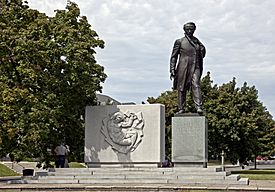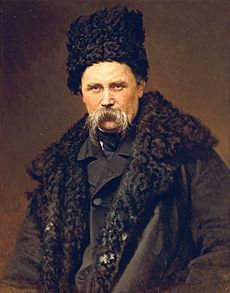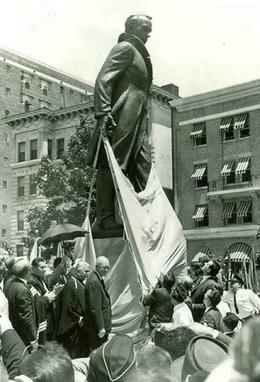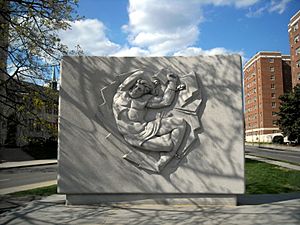Taras Shevchenko Memorial facts for kids
 |
|
| Coordinates | 38°54′36.06″N 77°2′56.25″W / 38.9100167°N 77.0489583°W |
|---|---|
| Location | 2200 block of P Street NW Washington, D.C., U.S. |
| Designer | Leo Mol (sculptor) Radoslav Zuk (architect) Jones Brothers Company (stonework) |
| Material | Bronze (statue) Granite (base, wall) |
| Length | 4.7 feet (1.4 m) |
| Width | 4.6 feet (1.4 m) |
| Height | 21 feet (6.4 m) |
| Beginning date | July 14, 1962 |
| Opening date | June 27, 1964 |
| Dedicated to | Taras Shevchenko |
The Taras Shevchenko Memorial is a bronze statue and a stone wall in Washington, D.C.. It is located on P Street NW in the Dupont Circle area. This memorial honors Taras Shevchenko (1814–1861). He was a famous Ukrainian poet and artist. Shevchenko helped shape modern Ukrainian literature.
Many monuments in Washington, D.C., celebrate heroes from other countries. These heroes often stand for freedom in their homelands. The committee that built this memorial included former U.S. President Harry S. Truman. The memorial was officially opened in 1964. This was 150 years after Shevchenko's birth. Important people attended the dedication. These included Ukrainian American leaders and former U.S. President Dwight D. Eisenhower.
The sculptor Leo Mol created the statue. This is one of two Ukrainian monuments in Washington, D.C. The other honors victims of the Holodomor, a terrible famine in Ukraine. The U.S. federal government takes care of the Taras Shevchenko Memorial.
Contents
History of the Shevchenko Memorial
Why the Memorial Was Built

Washington, D.C. has many memorials for American heroes. It also has artworks honoring heroes from other nations. For example, in Dupont Circle, there are memorials for Mahatma Gandhi of India and Tomáš Garrigue Masaryk of Czechoslovakia.
The idea for a U.S. monument to Shevchenko started in 1898. This was with the American Shevchenko Society. Ukrainian Americans kept working towards this goal. A key moment happened when Professor Ivan Dubrovsky wrote an article. He asked for support from Ukrainian groups. Thousands of Ukrainian Americans wrote letters to Congress. Lev Dobriansky, a Ukrainian American activist, became a strong supporter.
They gained help from Senator Jacob K. Javits and Representative Alvin Morell Bentley. Javits called Shevchenko a "bard of freedom." He said Shevchenko taught American ideals. Bentley said the statue would show U.S. appreciation for the Ukrainian people.
In April 1960, a bill to build the statue was discussed. Some government officials worried about too many monuments. The bill was delayed but later approved by Congress. On September 13, 1960, President Dwight D. Eisenhower signed the law. This law allowed the Shevchenko monument to be built.
The law stated that Shevchenko's work showed people's desire for freedom. It said he was inspired by American traditions. He fought against foreign control of his homeland. The law also said the monument would show the strong ties between the U.S. and Ukraine.
In September 1960, the Taras Shevchenko Memorial Committee was formed. Harry S. Truman was an honorary head. A design contest was announced. The winning design by Leo Mol was chosen on July 14, 1962. Mol was a Ukrainian Canadian artist. The memorial cost about $250,000. This money came from Ukrainian American groups and over 50,000 donors. The U.S. Commission of Fine Arts approved the design in April 1963.
Challenges and Opposition
Not everyone agreed with building a statue of Shevchenko. The Washington Post newspaper argued against it. They said few Americans knew Shevchenko. They also claimed he was liked by the Soviet Communist Party. After this, many angry responses came in. Members of Congress, like Representatives Thaddeus J. Dulski and Ed Derwinski, spoke up. Derwinski said Shevchenko was a fitting choice compared to other statues in the city.
After a groundbreaking ceremony in September 1963, calls to stop the project continued. Some officials tried to cancel the memorial. However, capital planners said they could not stop the statue's construction.
Initially, officials from the Soviet Union opposed the memorial. They asked the U.S. State Department to cancel the plans. But they later accepted the idea. However, the memorial's words were chosen to make the Soviet Union uncomfortable. This was to discourage them from laying wreaths there.
Memorial Dedication Ceremony

The statue was placed on its base on June 3, 1964. The dedication ceremony happened a few weeks later, on June 27. The day included concerts and a large parade. About 35,000 people of Ukrainian descent marched. Many wore traditional clothing. They marched from the Ellipse to the memorial site. The parade lasted four hours.
Around 100,000 people attended the ceremony. Delegations from many countries were there. U.S. government representatives and foreign ambassadors also attended. Important guests included Leo Mol, the sculptor. Also present were Ukrainian leaders and U.S. Representatives. Actors Jack Palance and Mike Mazurki were there too.
The ceremony began with the U.S. national anthem. Archbishop Ambrose Senyshyn gave a prayer in English and Ukrainian. Roman Smal-Stocki spoke about the monument's importance. Former U.S. President Eisenhower was the most famous guest. He was chosen to unveil the statue. The crowd cheered him for several minutes.
Eisenhower gave a 12-minute speech. He called Shevchenko a Ukrainian hero. He said the march and statue would inspire a new world movement. This movement would be for the freedom of all captive nations. He also said the statue represented millions of oppressed people. It would encourage them to fight against tyranny. After the unveiling, a choir sang Shevchenko's poem Testament. The ceremony ended with the crowd singing Ukraine's national anthem.
Recent History of the Memorial
In May 1965, a stainless steel container was placed at the memorial's base. It held soil from Shevchenko's grave. A book about the monument's history and donors was also put inside. The memorial became a place for Ukrainian Americans to protest Soviet policies. It is seen as a symbol of Ukrainian independence.
Ukrainian leaders still visit the memorial. President Viktor Yushchenko laid a wreath there in April 2005. Sviatoslav Shevchuk, head of the Ukrainian Greek Catholic Church, visited in 2014. The National Park Service manages the memorial site.
Second Ukrainian Monument in D.C.
In 2006, the U.S. Congress approved another monument. This one honors millions of Ukrainians who died in the Holodomor. This was a terrible famine caused by the Soviet Union in 1932–1933. The memorial is on Massachusetts Avenue NW.
A dedication ceremony for the future site was held on December 2, 2008. Ukraine’s First Lady, Kateryna Yushchenko, spoke there. The Holodomor Memorial was officially opened on November 7, 2015. It is the second memorial in Washington, D.C., honoring victims of Communism. The other is the Victims of Communism Memorial.
Design and Location of the Memorial

The memorial is in a triangular park. It is bordered by P Street and 22nd Street NW. It is near the Church of the Pilgrims. The memorial has a bronze statue on a granite base. Next to it is a granite wall with a relief.
The statue is about 14 feet (4.3 m) tall. It shows Shevchenko wearing a long coat. He is stepping forward with his left hand holding his jacket. His right hand points downwards. Shevchenko is shown as a young to middle-aged adult. He has short wavy hair and a mustache. The relief on the wall shows the Greek god Prometheus. The statue and wall stand on a four-step platform. This is surrounded by a stone plaza.
The memorial has several inscriptions:
- BEDI-RASSY ART FDRY. N.Y. (on the statue)
- TARAS / SHEVCHENKO / 1814–1861 / BARD OF UKRAINE (on the base, south side)
- DEDICATED TO / THE LIBERATION, FREEDOM AND / INDEPENDENCE OF ALL CAPTIVE NATIONS / THIS MONUMENT OF TARAS SHEVCHENKO, 19TH / CENTURY UKRAINIAN POET AND FIGHTER FOR / INDEPENDENCE OF UKRAINE AND THE FREEDOM / OF ALL MANKIND, WHO UNDER FOREIGN RUSSIAN / IMPERIALIST TYRANNY AND COLONIAL RULE / APPEALED FOR "THE NEW AND RIGHTEOUS LAW OF / WASHINGTON," WAS UNVEILED ON JUNE 27, 1964. / THIS HISTORIC EVENT COMMEMORATED THE / 150TH ANNIVERSARY OF SHEVCHENKO'S BIRTH. / THE MEMORIAL WAS AUTHORIZED BY THE 86TH / CONGRESS OF THE UNITED STATES OF AMERICA / ON AUGUST 31, 1960, AND SIGNED INTO PUBLIC / LAW 86-749 BY DWIGHT D. EISENHOWER, THE 34TH / PRESIDENT OF THE UNITED STATES OF AMERICA, / ON SEPTEMBER 13, 1960. THE STATUE WAS ERECTED / BY AMERICANS OF UKRAINIAN ANCESTRY AND FRIENDS. (on the base, north side)
- LEO MOL – SCULPTOR / RADOSLAV ZUK – ARCHITECT (on the base, lower north side)
- WHEN WILL UKRAINE / HAVE ITS WASHINGTON / WITH FAIR AND JUST LAWS? / SOMEDAY WE WILL! (on the base, west side)
- ...OUR SOUL SHALL NEVER PERISH, / FREEDOM KNOWS NO DYING, / AND THE GREEDY CANNOT HARVEST / FIELDS WHERE SEAS ARE LYING. // CANNOT BIND THE LIVING SPIRIT / NOR THE LIVING WORD / CANNOT SMIRCH THE SACRED GLORY / OF TH'ALMIGHTY LORD. // TARAS SHEVCHENKO 'THE CAUCASUS.' 1845. (on the wall, north side)
The inscription on the west side of the base is a translation. It is a quote from Shevchenko's 1857 poem, The Holy Fool.
See also
 In Spanish: Monumento conmemorativo a Taras Shevchenko para niños
In Spanish: Monumento conmemorativo a Taras Shevchenko para niños

